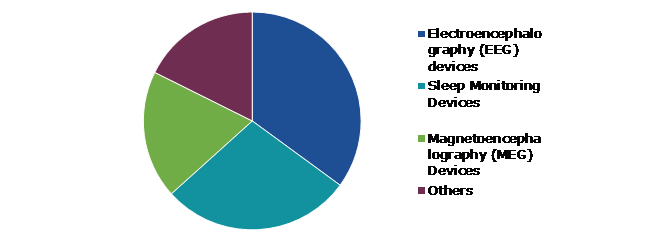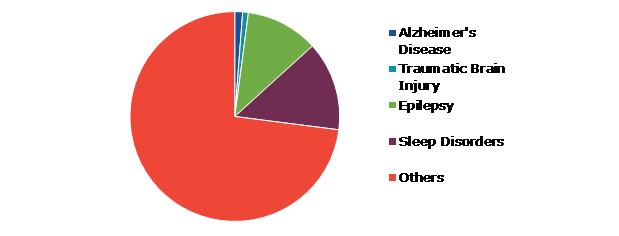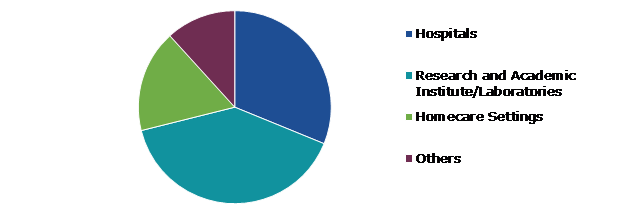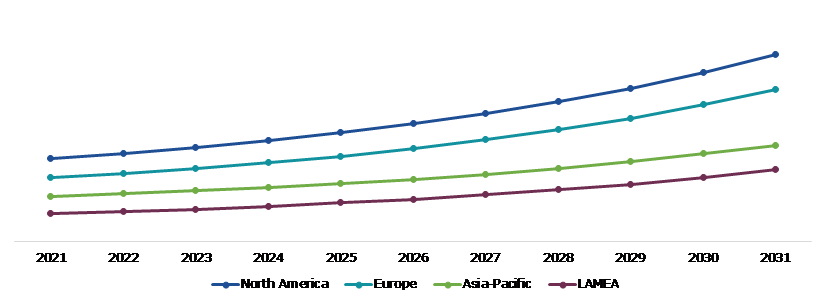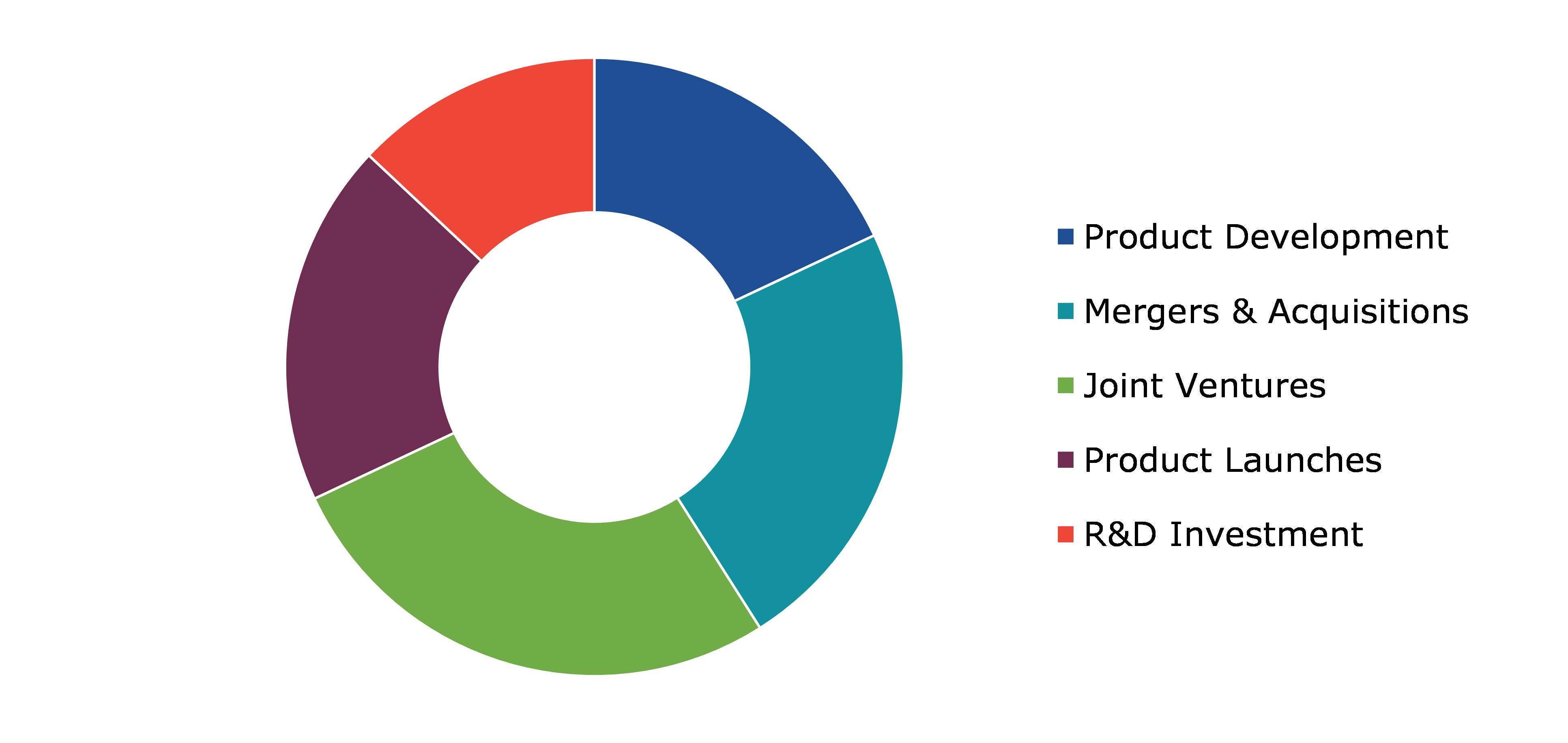Wireless Brain Sensors Market Report
RA08589
Wireless Brain Sensors Market by Product Type (Electroencephalography (EEG) devices, Sleep Monitoring Devices, Magnetoencephalography (MEG) Devices, and Others), Application (Alzheimer's Disease, Traumatic Brain Injury, Epilepsy, Sleep Disorders, and Others), and End User (Hospitals, Research and Academic Institute/Laboratories, Homecare Settings, and Others): Global Opportunity Analysis and Industry Forecast, 2022-2031
Global Wireless Brain Sensors Market Analysis
The global wireless brain sensors market size was $677.8 million in 2021 and is predicted to grow with a CAGR of 9.0%, by generating a revenue of $1,566.7 million by 2031.
Global Wireless Brain Sensor Market Synopsis
Increasing prevalence of traumatic brain injuries (TBI) is expected to increase the demand for wireless brain sensors market trend. TBIs are caused by a blow, bump, or shock to the head, which results in either permanent or temporary brain damage. TBIs are commonly caused by gunshot wounds, sports injuries, falls, domestic abuse, and vehicle accidents. Increase in the number of road accidents is expected to rise the demand for wireless brain sensors, thus, propelling the market growth even further. Another key driver is rise in prevalence of neurological illnesses, such as Alzheimer's disease, Parkinson's disease, epilepsy, and others. Furthermore, rising healthcare spending capacity and advancements in healthcare infrastructure are expected to be important drivers of the wireless brain sensors market growth. Rapid urbanization and rising disposable income levels in emerging and developed nations are expected to have an impact on the growth of the wireless brain sensors market.
However, expensive sensors costs and difficult-to-understand device functionality are hindering market growth. The wireless brain sensors market demand is further limited by stringent safety and validation requirements. The market expansion is hampered by shortage of trained professionals and compatibility issues.
Increase in the number of government initiatives, as well as developments in developing nations' clinical development framework, is anticipated to give advantageous prospects for the expansion of the wireless brain sensors market. Furthermore, rise in demand for wireless brain sensors from new economies and technological advancements are expected to boost the growth rate of the wireless brain sensors market growth in the future.
Wireless Brain Sensors Overview
Wireless brain sensors are used to monitor the intracranial pressure and temperature of people who have suffered severe traumatic brain injuries. Electroencephalography devices, sleep monitoring devices, transcranial Doppler devices, and other wireless brain sensors help to monitor brain changes and improve cognitive capacities. These wireless sensors may be accessible over wireless networking using a smartphone, tablet, or computer, making the device more cost-effective.
COVID-19 Impact on Global Wireless Brain Sensor Market
The COVID-19 impact on wireless brain sensors market had a significant impact on the global economy at several levels, including the wireless brain sensors market. Growing market of healthcare research and development is likely to have a sharp drop in sales during the lockdown period owing to the shutdown of production facilities, severe shortage of raw materials, and lack of prospective workforce. In addition, availability of labor is apparently disrupting the inventory network of the global wireless brain sensors market, as the lockdown and spread of the disease caused people to stay in the house. The wireless brain sensors manufacturers and the shipping of items are connected. If the assembly process is halted, transportation and the retail network are also halted. The pandemic also had a negative impact on the stacking and dumping of products, such as raw materials and results (fixings).
However, in August 2021, the Careline Health Group, a healthcare organization, took new initiative and used Muse Healthcare's machine learning and predictive modelling capabilities to address the demands of its patients. The technology aids in the evaluation and modelling of every clinical assessment, medicine, vital sign, and other important data to perform risk stratification of various patients. It also makes correct modifications to treatment plans, based on the status and location of patients.
Rise in prevalence of brain-related disorders is major driving force in the wireless brain sensors industry
Increased frequency of brain-related diseases as a result of higher stress levels and changes in lifestyle have been critical elements driving the wireless brain sensors market. Brain disorders, which mainly relate to a mix of developmental, psychiatric, and neurodegenerative diseases, are an increasing cause of death globally. Furthermore, substantial changes in social contexts have cumulatively increased demand for wireless brain sensors. The increasing number of people suffering from brain-related disorders has increased spending on research and development in the field. According to the Parkinson's Foundation, nearly one million people in the U.S. had Parkinson's disease in 2020, which is more than the total number of people diagnosed with muscular dystrophy, multiple sclerosis, and Lou Gehrig's disease (or Amyotrophic Lateral Sclerosis), and more than 10 million people globally have Parkinson's disease.
To know more about global wireless brain market drivers, get in touch with our analysts here.
Health-Related Concerns and High Cost of Using Wireless Brain Sensors Restrain Market Growth
Health-related concerns and the high cost of using wireless brain sensors are two factors that are expected to limit the growth of the global wireless brain sensors market during the forecast period. A wireless brain sensor is an absorbable device built of silicon sheets in the 20-nanometer range with numerous water-soluble and biocompatible metals such as magnesium, titanium, and zinc. It may be used as a conducting component and is largely made up of polymers that can be reassembled to modify the dissolving rate.
Rising Demand from Developing Economies and Technological Improvements to Drive Excellent Opportunities
Scientists have created new technological improvement of high-data-rate, low-power wireless brain sensors, which is expected to make neuroscience research easier than it was a decade ago. The system is intended to enable brain research that is now not possible with sensors connected by cabled connections. According to the results, the technique conveyed rich and significant data from animal models as they slept, woke up, or exercised. Furthermore, constant technological advances are likely to considerably contribute to the market growth in the future. Other factors boosting business expansion include, increase in the frequency of traffic accidents, government efforts, and developments in the clinical development framework of developing countries. This factor boosts the wireless brain sensor market opportunity during the upcoming years.
To know more about global wireless brain sensors market opportunities, get in touch with our analysts here.
Global Wireless Brain Sensors Market Trends, by Product Type
By product type, the market has been divided into electroencephalography (EEG) devices, sleep monitoring devices, magnetoencephalography (MEG) devices, and others. Among these, the electroencephalography (EEG) devices segment accounted for the highest market share in 2021 whereas the magnetoencephalography (MEG) devices segment is estimated to show the fastest growth during the forecast period.
Global Wireless Brain Sensors Market Share, by Product Type, 2021
Source: Research Dive Analysis
The electroencephalography (EEG) devices segment is anticipated to have a dominant wireless brain sensors market share in 2021. Increasing rates of brain injuries, migraines, strokes, and other conditions are likely to drive the growth of the electroencephalography devices segment in terms of revenue, to the global wireless brain sensors market during the forecast period. To be able to identify this form of lesion at an early stage, such devices help gather and record the electrical activity of the brain. The signals are amplified and converted to digital form before being transferred to computers or mobile devices for data processing and storage. Using such tools, people can track their emotions and moods to increase their productivity and overall wellness.
The magnetoencephalography (MEG) devices segment is anticipated to show the fastest growth wireless brain sensors market share by 2031. Magnetoencephalography (MEG) is a non-invasive method for analyzing brain activity in living things. It enables millisecond-by-millisecond assessment of ongoing brain activity and identifies the sections of the brain responsible for the activity. MEG can help to more precisely design the implantation site when the implantation of intracranial electrodes is required. MEG technology gives patients undergoing neurosurgery useful data for presurgical mapping in a noninvasive manner. There is currently no other method for researching the brain that combines structural and functional information, in such a way as MEG technology does. This combination results in great spatial resolution and high temporal resolution.
Global Wireless Brian Sensors Market Size, by Application
By application, the market has been divided into Alzheimer's disease, traumatic brain injury, epilepsy, sleep disorders, and others. Among these, the alzheimer's disease segment is estimated to show the fastest growth during the forecast period.
Global Wireless Brian Sensors Market Share, by Application, 2021
Source: Research Dive Analysis
The Alzheimer's disease segment is anticipated to show the fastest growth by 2031. Alzheimer's disease is a degenerative neurologic ailment that causes brain cells to die and the brain to shrink (atrophy). Alzheimer's disease is the most prevalent form of dementia, which is defined as a progressive deterioration in cognitive, behavioral, and social abilities that impairs a person's capacity to operate independently.
In the U.S., 5.8 million adults who are 65 and older have Alzheimer's disease, and of the estimated 50 million people with dementia worldwide, 70% are predicted to have Alzheimer's disease. During the forecast period, these variables are predicted to accelerate the growth of the Alzheimer's disease segment.
Global Wireless Brian Sensors Market Forecast, by End User
By end user, the market is divided into hospitals, research and academic institute/laboratories, homecare settings, and others. Among these, the hospitals segment accounted for the second highest market share in 2021.
Global Wireless Brian Sensors Market Share, by End-user, 2021
Source: Research Dive Analysis
The hospitals segment had the fastest market growth in 2021. Hospitals are currently advancing in terms of technology. Brain examination is a difficult procedure that necessitates the use of expensive and advanced equipment that is often found only in hospitals. In hospitals, technologically advanced technologies are often employed to give better care. These gadgets not only make treatment processes easier, but they also deliver better, quicker, and more accurate outcomes. Almost all neurological illnesses and disorders, including severe TBIs, are identified and treated using modern technology employed by trained neurologists in specialty hospitals. When compared to clinics and other end users, hospitals see a much larger intake of patients suffering from head injuries.
Wireless Brain Sensors Market Value, Regional Insights
The wireless brain sensors market is analyzed across North America, Europe, Asia-Pacific, and LAMEA.
Global Wireless Brain Sensors Market Size & Forecast, by Region, 2021-2031 ($ Million)
Source: Research Dive Analysis
The Market for Wireless Brain Sensors in North America to be Most Dominant
The North America wireless brain sensors market analysis was dominant in 2021 owing to the presence of a bigger patient pool and increased product development spending. In addition, well-established insurance plans and availability of superior healthcare infrastructure are two major factors driving the industry in this area. Due to reasons such as rising number of neurological illnesses in the country, the U.S. owns the greatest wireless brain sensors market size in North America.
According to Health Union, LLC, around 1 million Americans have Parkinson's disease, and roughly 60,000 are diagnosed with the condition each year.
Competitive Scenario in the Global Wireless Brain Sensors Market
Product launches and product expansions are common strategies followed by major market players. For instance, on May 2O21, Neuroelectrics, a pioneer in brain stimulation technology and therapeutics, secured $17.5 million in a Series A round headed by Morningside Ventures. The funding is expected to be used to further develop Neuroelectrics' non-invasive transcranial electrical stimulation therapy technology, as well as to progress clinical studies in refractory focal epilepsy and at-home treatment of refractory depression.
Source: Research Dive Analysis
Some of the leading wireless brain sensors market players are NeuroSky, EMOTIV, Advanced Brain Monitoring, Inc., Koninklijke Philips N.V., Medtronic, Muse, Natus Medical Incorporated, Cadwell Industries, Inc., NeuroWave Systems Inc., and BrainScope.
| Aspect | Particulars |
| Historical Market Estimations | 2020 |
| Base Year for Market Estimation | 2021 |
| Forecast Timeline for Market Projection | 2022-2031 |
| Geographical Scope | North America, Europe, Asia-Pacific, and LAMEA |
| Segmentation by Product Type |
|
| Segmentation by Application |
|
| Segmentation by End-user |
|
| Key Companies Profiled |
|
Q1. What is the size of the global wireless brain sensors market?
A. The size of the global wireless brain sensors market size was over $677.8 million in 2021 and is projected to reach $1,566.7 million by 2031.
Q2. Which are the major companies in the wireless brain sensors market?
A. NeuroSky, EMOTIV, and Advanced Brain Monitoring, Inc. are some of the key players in the global wireless brain sensors market.
Q3. Which region possesses greater investment opportunities in the near future?
A. The LAMEA region is expected to possess great investment opportunities for investors in the future.
Q4. What will be the growth rate of the Asia-Pacific wireless brain sensors market?
A. The Asia-Pacific wireless brain sensors market is anticipated to grow at a CAGR of 8.2% during the forecast period.
Q5. What are the strategies opted by leading players in this market?
A. Agreement and investment are the two key strategies opted by operating companies in this market.
Q6. Which companies are investing more on R&D practices?
A. NeuroSky, EMOTIV, Advanced Brain Monitoring, Inc., Koninklijke Philips N.V., Medtronic, Muse, Natus Medical Incorporated, Cadwell Industries, Inc., NeuroWave Systems Inc., and BrainScope. are the companies investing more on R&D activities for developing new products and technologies.
1.Research Methodology
1.1.Desk Research
1.2.Real time insights and validation
1.3.Forecast model
1.4.Assumptions and forecast parameters
1.5.Market size estimation
1.5.1.Top-down approach
1.5.2.Bottom-up approach
2.Report Scope
2.1.Market definition
2.2.Key objectives of the study
2.3.Report overview
2.4.Market segmentation
2.5.Overview of the impact of COVID-19 on Global wireless brain sensors market
3.Executive Summary
4.Market Overview
4.1.Introduction
4.2.Growth impact forces
4.2.1.Drivers
4.2.2.Restraints
4.2.3.Opportunities
4.3.Market value chain analysis
4.3.1.List of raw material suppliers
4.3.2.List of manufacturers
4.3.3.List of distributors
4.4.Innovation & sustainability matrices
4.4.1.Technology matrix
4.4.2.Regulatory matrix
4.5.Porter’s five forces analysis
4.5.1.Bargaining power of suppliers
4.5.2.Bargaining power of consumers
4.5.3.Threat of substitutes
4.5.4.Threat of new entrants
4.5.5.Competitive rivalry intensity
4.6.PESTLE analysis
4.6.1.Political
4.6.2.Economical
4.6.3.Social
4.6.4.Technological
4.6.5.Environmental
4.7.Impact of COVID-19 on wireless brain sensors market
4.7.1.Pre-covid market scenario
4.7.2.Post-covid market scenario
5.Wireless Brain Sensors Market Analysis, by Product Type
5.1.Overview
5.2.Electroencephalography (EEG) devices
5.2.1.Definition, key trends, growth factors, and opportunities
5.2.2.Market size analysis, by region
5.2.3.Market share analysis, by country
5.3.Sleep Monitoring Devices
5.3.1.Definition, key trends, growth factors, and opportunities
5.3.2.Market size analysis, by region
5.3.3.Market share analysis, by country
5.4.Magnetoencephalography (MEG) Devices
5.4.1.Definition, key trends, growth factors, and opportunities
5.4.2.Market size analysis, by region
5.4.3.Market share analysis, by country
5.5.Others
5.5.1.Definition, key trends, growth factors, and opportunities
5.5.2.Market size analysis, by region
5.5.3.Market share analysis, by country
5.6.Research Dive Exclusive Insights
5.6.1.Market attractiveness
5.6.2.Competition heatmap
6.Wireless Brain Sensors Market Analysis, by Application
6.1.Alzheimer's Disease
6.1.1.Definition, key trends, growth factors, and opportunities
6.1.2.Market size analysis, by region
6.1.3.Market share analysis, by country
6.2.Traumatic Brain Injury
6.2.1.Definition, key trends, growth factors, and opportunities
6.2.2.Market size analysis, by region
6.2.3.Market share analysis, by country
6.3.Epilepsy
6.3.1.Definition, key trends, growth factors, and opportunities
6.3.2.Market size analysis, by region
6.3.3.Market share analysis, by country
6.4.Sleep Disorders
6.4.1.Definition, key trends, growth factors, and opportunities
6.4.2.Market size analysis, by region
6.4.3.Market share analysis, by country
6.5.Others
6.5.1.Definition, key trends, growth factors, and opportunities
6.5.2.Market size analysis, by region
6.5.3.Market share analysis, by country
6.6.Research Dive Exclusive Insights
6.6.1.Market attractiveness
6.6.2.Competition heatmap
7.Wireless Brain Sensors Market Analysis, by End User
7.1.Hospitals
7.1.1.Definition, key trends, growth factors, and opportunities
7.1.2.Market size analysis, by region
7.1.3.Market share analysis, by country
7.2.Research and Academic Institute/Laboratories
7.2.1.Definition, key trends, growth factors, and opportunities
7.2.2.Market size analysis, by region
7.2.3.Market share analysis, by country
7.3.Homecare Settings
7.3.1.Definition, key trends, growth factors, and opportunities
7.3.2.Market size analysis, by region
7.3.3.Market share analysis, by country
7.4.Others
7.4.1.Definition, key trends, growth factors, and opportunities
7.4.2.Market size analysis, by region
7.4.3.Market share analysis, by country
7.5.Research Dive Exclusive Insights
7.5.1.Market attractiveness
7.5.2.Competition heatmap
8.Wireless Brain Sensors Market, by Region
8.1.North America
8.1.1.U.S.
8.1.1.1.Market size analysis, by Product Type
8.1.1.2.Market size analysis, by Application
8.1.1.3.Market size analysis, by End User
8.1.2.Canada
8.1.2.1.Market size analysis, by Product Type
8.1.2.2.Market size analysis, by Application
8.1.2.3.Market size analysis, by End User
8.1.3.Mexico
8.1.3.1.Market size analysis, by Product Type
8.1.3.2.Market size analysis, by Application
8.1.3.3.Market size analysis, by End User
8.1.4.Research Dive Exclusive Insights
8.1.4.1.Market attractiveness
8.1.4.2.Competition heatmap
8.2.Europe
8.2.1.Germany
8.2.1.1.Market size analysis, by Product Type
8.2.1.2.Market size analysis, by Application
8.2.1.3.Market size analysis, by End User
8.2.2.UK
8.2.2.1.Market size analysis, by Product Type
8.2.2.2.Market size analysis, by Application
8.2.2.3.Market size analysis, by End User
8.2.3.France
8.2.3.1.Market size analysis, by Product Type
8.2.3.2.Market size analysis, by Application
8.2.3.3.Market size analysis, by End User
8.2.4.Spain
8.2.4.1.Market size analysis, by Product Type
8.2.4.2.Market size analysis, by Application
8.2.4.3.Market size analysis, by End User
8.2.5.Italy
8.2.5.1.Market size analysis, by Product Type
8.2.5.2.Market size analysis, by Application
8.2.5.3.Market size analysis, by End User
8.2.6.Rest of Europe
8.2.6.1.Market size analysis, by Product Type
8.2.6.2.Market size analysis, by Application
8.2.6.3.Market size analysis, by End User
8.2.7.Research Dive Exclusive Insights
8.2.7.1.Market attractiveness
8.2.7.2.Competition heatmap
8.3.Asia Pacific
8.3.1.China
8.3.1.1.Market size analysis, by Product Type
8.3.1.2.Market size analysis, by Application
8.3.1.3.Market size analysis, by End User
8.3.2.Japan
8.3.2.1.Market size analysis, by Product Type
8.3.2.2.Market size analysis, by Application
8.3.2.3.Market size analysis, by End User
8.3.3.India
8.3.3.1.Market size analysis, by Product Type
8.3.3.2.Market size analysis, by Application
8.3.3.3.Market size analysis, by End User
8.3.4.Australia
8.3.4.1.Market size analysis, by Product Type
8.3.4.2.Market size analysis, by Application
8.3.4.3.Market size analysis, by End User
8.3.5.South Korea
8.3.5.1.Market size analysis, by Product Type
8.3.5.2.Market size analysis, by Application
8.3.5.3.Market size analysis, by End User
8.3.6.Rest of Asia Pacific
8.3.6.1.Market size analysis, by Product Type
8.3.6.2.Market size analysis, by Application
8.3.6.3.Market size analysis, by End User
8.3.7.Research Dive Exclusive Insights
8.3.7.1.Market attractiveness
8.3.7.2.Competition heatmap
8.4.LAMEA
8.4.1.Brazil
8.4.1.1.Market size analysis, by Product Type
8.4.1.2.Market size analysis, by Application
8.4.1.3.Market size analysis, by End User
8.4.2.Saudi Arabia
8.4.2.1.Market size analysis, by Product Type
8.4.2.2.Market size analysis, by Application
8.4.2.3.Market size analysis, by End User
8.4.3.UAE
8.4.3.1.Market size analysis, by Product Type
8.4.3.2.Market size analysis, by Application
8.4.3.3.Market size analysis, by End User
8.4.4.South Africa
8.4.4.1.Market size analysis, by Product Type
8.4.4.2.Market size analysis, by Application
8.4.4.3.Market size analysis, by End User
8.4.5.Rest of LAMEA
8.4.5.1.Market size analysis, by Product Type
8.4.5.2.Market size analysis, by Application
8.4.5.3.Market size analysis, by End User
8.4.6.Research Dive Exclusive Insights
8.4.6.1.Market attractiveness
8.4.6.2.Competition heatmap
9.Competitive Landscape
9.1.Top winning strategies, 2021
9.1.1.By strategy
9.1.2.By year
9.2.Strategic overview
9.3.Market share analysis, 2021
10.Company Profiles
10.1.NeuroSky
10.1.1.Overview
10.1.2.Business segments
10.1.3.Product portfolio
10.1.4.Financial performance
10.1.5.Recent developments
10.1.6.SWOT analysis
10.2.EMOTIV
10.2.1.Overview
10.2.2.Business segments
10.2.3.Product portfolio
10.2.4.Financial performance
10.2.5.Recent developments
10.2.6.SWOT analysis
10.3.Advanced Brain Monitoring, Inc.
10.3.1.Overview
10.3.2.Business segments
10.3.3.Product portfolio
10.3.4.Financial performance
10.3.5.Recent developments
10.3.6.SWOT analysis
10.4.Koninklijke Philips N.V.
10.4.1.Overview
10.4.2.Business segments
10.4.3.Product portfolio
10.4.4.Financial performance
10.4.5.Recent developments
10.4.6.SWOT analysis
10.5.Medtronic Plc
10.5.1.Overview
10.5.2.Business segments
10.5.3.Product portfolio
10.5.4.Financial performance
10.5.5.Recent developments
10.5.6.SWOT analysis
10.6.InteraXon Inc.
10.6.1.Overview
10.6.2.Business segments
10.6.3.Product portfolio
10.6.4.Financial performance
10.6.5.Recent developments
10.6.6.SWOT analysis
10.7.Natus Medical Incorporated
10.7.1.Overview
10.7.2.Business segments
10.7.3.Product portfolio
10.7.4.Financial performance
10.7.5.Recent developments
10.7.6.SWOT analysis
10.8.Cadwell Industries, Inc.
10.8.1.Overview
10.8.2.Business segments
10.8.3.Product portfolio
10.8.4.Financial performance
10.8.5.Recent developments
10.8.6.SWOT analysis
10.9.NeuroWave Systems Inc.
10.9.1.Overview
10.9.2.Business segments
10.9.3.Product portfolio
10.9.4.Financial performance
10.9.5.Recent developments
10.9.6.SWOT analysis
10.10.BrainScope
10.10.1.Overview
10.10.2.Business segments
10.10.3.Product portfolio
10.10.4.Financial performance
10.10.5.Recent developments
10.10.6.SWOT analysis
11.Appendix
11.1.Parent & peer market analysis
11.2.Premium insights from industry experts
11.3.Related reports
Wearable electronic devices have gained tremendous popularity over the past few decades. The minimal level of user discomfort offered by these wearable sensors is one of their main advantages, but another crucial feature is that they provide continuous detection of biological signals from the user's body. In addition, wireless sensors free the user from being bound by a cord that connects the sensor to the analyser, allowing them to engage in a variety of daily activities. One such amazing wireless sensor technology device is a wireless brain sensor.
Wireless brain sensors are tools that can measure the pressure inside the brain, the temperature and pH of the brain, and the activity of the brain in the form of "brain waves," which are electrical impulses within the brain. External wireless sensors can be used to monitor brain activity patterns to aid in the diagnosis, investigation, and treatment of diseases linked to brain dysfunction. Neuronal interfaces called brain-computer interfaces (BCI) allow the continuous monitoring of the brain’s electrical activity throughout the day and wireless transmission of the data from the brain to external analysis devices. The global wireless brain sensors market is expanding at a rapid pace due to ongoing research & developments and investments in wireless brain sensors.
Newest Insights in the Wireless Brain Sensors Market
Numerous people with illnesses like Parkinson's disease, sleep difficulties, traumatic brain injury, dementia, and other brain-related ailments have benefited from recent advancements in the field of wireless brain sensors. As per a report by Research Dive, the global wireless brain sensors market is expected to surpass a revenue of $1,566.7 million in the 2022-2031 timeframe. The North America wireless brain sensors market is expected to perceive foremost and dominant growth in the years to come. This is because the region has a gigantic demand for wireless brain sensors owing to the growing number of patients with neurological disorders in the region.
How are Market Players Responding to the Rising Demand for Wireless Brain Sensors?
Market players are greatly investing in pioneering research and inventions to cater for the rising demand for wireless brain sensor devices. Some of the foremost players in the wireless brain sensors market are Medtronic, Natus Medical Incorporated, NeuroWave Systems Inc., NeuroSky, EMOTIV, Koninklijke Philips N.V., Muse, Cadwell Industries, Inc., Advanced Brain Monitoring, Inc., BrainScope, and others. These players are focused on planning and devising tactics such as mergers and acquisitions, collaborations, novel advances, and partnerships to reach a notable position in the global market.
For instance,
- In December 2020, NextMind, a neurotechnology startup, announced that it has begun the delivery of its Development Kit for the world’s first real-time brain-sensing wearable device, which enables users to take control of their digital world just by using their thoughts.
- In December 2021, iMediSync, a foremost AI-based early detection & therapeutic platform provider for optimum brain health from Seoul, South Korea, announced that it will unveil its all-inclusive EEG solution, which can perform brain mental health screening and predictive analysis of prospective mental disorders in merely 10 minutes.
- In November 2022, EMOTIV, a bioinformatics firm focused on improving the understanding of the human brain using electroencephalography (EEG), partnered with X-trodes, a firm focused on making wireless medical-grade monitoring solutions. The partnership aims to pair X-trodes' wearable sensing technology with EMOTIV's EmotivPRO, an EEG data platform for neuroscience research.
COVID-19 Impact on the Global Wireless Brain Sensors Market
The unpredicted rise of the coronavirus pandemic in 2020 has adversely impacted the global wireless brain sensors market. During the pandemic period, a dearth of skilled professionals, the shutdown of production facilities, and a shortage of raw materials greatly affected the production and sales of wireless brain sensor devices. This resulted in a drastic decline in the global market growth during the pandemic. However, with the relaxation of the pandemic since the end of 2021, many medical device makers got back on track and came up with advanced medical device solutions to cater for the rising demand, which is projected to drive the growth of the wireless brain sensors market in the forthcoming years.
Personalize this research
- Triangulate with your own data
- Request your format and definition
- Get a deeper dive on a specific application, geography, customer or competitor
- + 1-888-961-4454 Toll - Free
- support@researchdive.com


